Chapter- 9 AGRICULTURE AND FOOD MANAGEMENT: PLENTY OF UPSIDE LEFT IF WE GET IT RIGHT
Over the past five years, India’s agriculture sector has grown at an average rate of 4.18% annually, with a substantial stock of foodgrains and significant exports. Despite this growth, challenges like low productivity, weather variability, fragmented land holdings, and inadequate marketing infrastructure persist. The chapter discusses government interventions in crops, livestock, animal husbandry, and fisheries to boost investment and productivity, ensure fair returns through MSP, improve input quality, and enhance extension services. Digitalisation initiatives are expected to empower farmers. Additionally, welfare schemes like PM Gareeb Kalyan Yojana and the National Food Security Act are discussed, focusing on food procurement and distribution.
Introduction
- Introduction
- Agriculture production: performance and Promoting crop diversification
- Promoting Investment and Access to credit in Agriculture and allied sectors
- Empowering farmers through affordable and enhanced access to credit
- Agriculture Marketing-Reaping prosperity
- Assured Remunerative Prices and Other Income Support Measures
- ANIMAL HUSBANDRY, DAIRYING AND FISHERIES ARE SIGNIFICANT GROWTH DRIVERS
- Food processing sector (FPI): Processing Potential
- Social net for food security
- The Indian agriculture sector provides livelihood support to about 42.3 per cent of the population and has a share of 18.2 per cent in the country’s GDP3 at current prices. It has registered an average annual growth rate of 4.18 per cent at constant prices over the last five years. As per provisional estimates for 2023-24, the growth rate of the agriculture sector stood at 1.4 per cent, which is below 4.7 per cent in 2022-23, mainly because of a drop in the food grain production due to delayed and poor monsoons caused by El Nino.
- The allied activities – livestock and fisheries have increased their share in agriculture Gross Value Added (GVA) at current prices from 24.38 per cent and 4.44 per cent in 2014-15 to 30.23 per cent and 7.25 per cent in 2022-23 respectively.
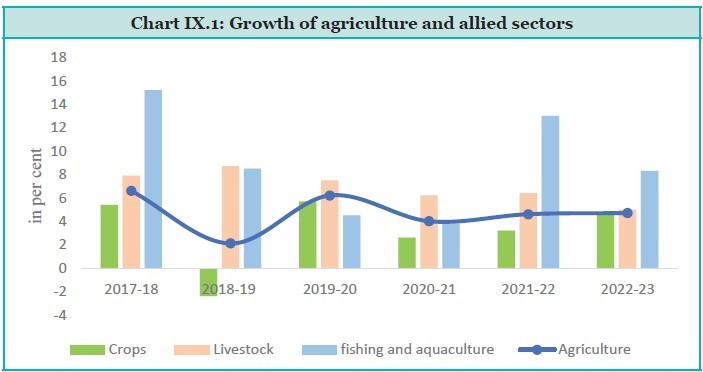
- India is second largest producer in rice, wheat, cotton, among other crops, and the largest producer of milk, pulses and spices.
- The crop yields in the country are much lower than the other major producers due to Fragmented land holdings, low farm investment, lack of farm mechanisation, insufficient access to quality inputs, and inadequate marketing infrastructure leading to postharvest losses, dependency on rains and short growing seasons are a few reasons for the low yields.
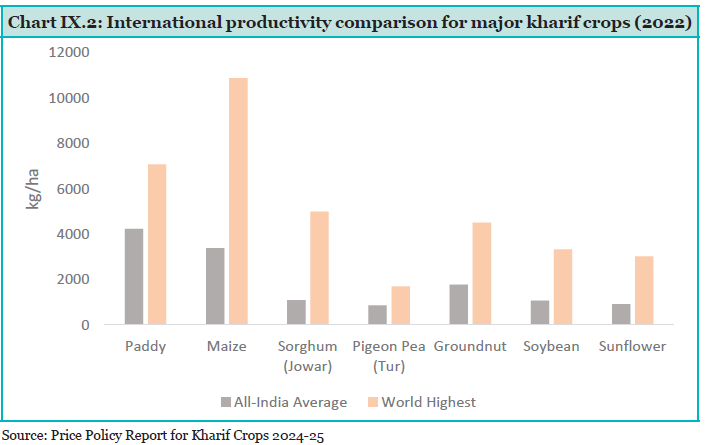
Agriculture production: performance and Promoting crop diversification
- In 2022-23, foodgrain production hit an all-time high of 329.7 million tonnes, and oilseeds production reached 41.4 million tonnes. In 2023-24, food grain production is slightly lower at 328.8 million tonnes, primarily because of poor and delayed monsoons.
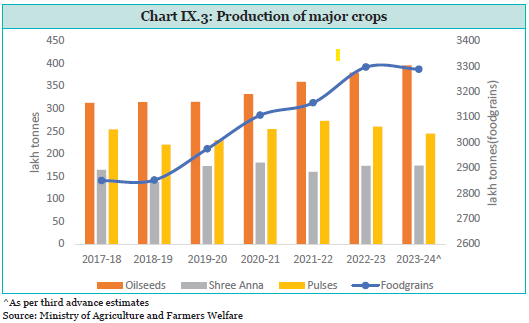
- The National Food Security Mission (NFSM) is implemented across the country to enhance the production and productivity of foodgrain and commercial crops through the demonstration of crop production and protection technologies, access to high-yielding varieties, integrated nutrient and pest management techniques, efficient water saving devices, and capacity building of farmers etc.
- The Government has been implementing a National Food Security Mission- Oilseeds & Oil Palm (NFSM-OS&OP), from 2018-19 to augment the availability of vegetable oils through improved productivity and increase in acreage under cultivation. The total area coverage of all oilseeds has expanded significantly, increasing from 25.60 million hectares in 2014-15 to 30.08 million hectares in 2023-24 (17.5 per cent growth).
Promoting Investment and Access to credit in Agriculture and allied sectors
| Gross capital formation (GCF) |
| Gross capital formation (GCF) refers to the total investment in physical assets over a specific period. It includes new and existing fixed assets, such as machinery, buildings, land improvements, equipment purchases, and inventory change |
- The GCF of the agriculture sector grew at the rate of 19.04 per cent in 2022-23, and the GCF as a percentage of GVA rose from 17.7 per cent in 2021-22 to 19.9 per cent in 2022-23, suggesting an increase in investment in agriculture.
- However, despite the increasing trend in GCF, there is a need to further boost agriculture investment, especially in the context of doubling farmers’ income.

- Recognising the need to crowd in private investments, the government, since 2014, has been implementing the Agriculture Marketing Infrastructure (AMI) sub-scheme of the Integrated Scheme for Agricultural Marketing (ISAM).
- To give further fillip to farm gate infrastructure and also involve the private sector more actively, the Agriculture Infrastructure Fund (AIF) was launched with a financing facility of ₹1 lakh Crore to be disbursed between FY 2020-21 to FY 2025-26
Empowering farmers through affordable and enhanced access to credit
- As of 31 January 2024, the total credit disbursed to agriculture amounted to ₹ 22.84 lakh Crore, with ₹13.67 lakh Crore allocated to crop loans (short term) and ₹ 9.17 lakh Crore to term loans.
- The Kisan Credit Card (KCC) has streamlined agricultural credit accessibility. As of January 31, 2024, banks issued 7.5 crores KCC with a limit of ₹9.4 lakh crores.
- PMFBY is the largest crop insurance scheme in the world in terms of farmer enrolment and is the third largest scheme in terms of insurance premiums. It offer a safety net against crop losses due to natural calamities, pests, or diseases, ensuring financial stability for farmers.
Agriculture Marketing-Reaping prosperity
- A comprehensive and diversified marketing network enables the farmer to bring the produce to the market most efficiently and timely. It reduces post-harvest losses, enhances competition, and allows price discovery.
- To Promote efficiency in agriculture marketing, and improve price discovery, the government implemented the e-NAM Scheme. Under the e-NAM Scheme, the Government provides free software and assistance of ₹75 Lakh per APMC mandis.
Assured Remunerative Prices and Other Income Support Measures
- Minimum Support Price: It is a factor farmers take into account when making sowing decisions. The Union Budget for 2018-19 announced that farmers in India would be given an MSP of at least one and a half times the cost of production. Accordingly, the Government has been increasing the MSP for all 22 Kharif, Rabi and other commercial crops.
- PM-KISAN: Another initiative towards increasing farmers’ income is PM-KISAN – a central sector scheme launched on 24 February 2019 to supplement the financial needs of land-holding farmers, subject to exclusions.
- Pradhan Mantri Kisan Maandhan Yojna (PMKMY): This scheme offers a monthly pension of ₹3,000 to the enrolled farmers on the attainment of 60 years of age, based on a nominal premium between ₹55 to ₹200 per month paid by the applicant.
ANIMAL HUSBANDRY, DAIRYING AND FISHERIES ARE SIGNIFICANT GROWTH DRIVERS
- From 2014-15 to 2022-23, the livestock sector grew at an impressive Compound Annual Growth Rate (CAGR) of 7.38 per cent at constant prices. The contribution of livestock to the total GVA (at constant prices) in agriculture and allied sectors increased from 24.32 per cent in 2014-15 to 30.38 per cent in 2022-23.
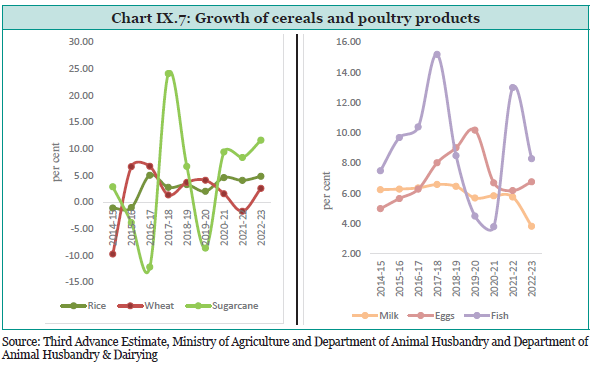
- In 2022-23, India achieved a record fish production of 17.54 million tons, ranking third globally and accounting for 8 per cent of global production. Pradhan Mantri Matsya Sampada Yojana (PMMSY) has been launched for the growth of this sector.
Food processing sector (FPI): Processing Potential
- India is the largest producer of milk and the second largest producer of fruits, vegetables and sugar. The availability of reasonably priced agricultural inputs, the vast labour force, and continuously growing consumer demand provide the essential elements for a robust food processing industry.
- The value of agri-food exports, including processed food exports during 2022-23, was USD46.4 Billion, accounting for about 11.7 per cent of India’s total exports. The share of processed food exports also increased from 14.9 per cent in 2017-18 to 23.4 per cent in 2022-23.
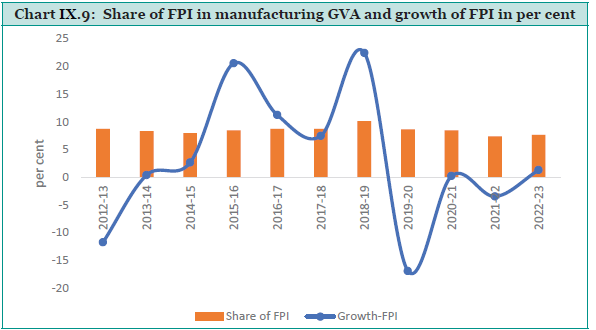
- The Production Linked Incentive Scheme for the Food Processing Industry (PLISFPI) supports the creation of global food manufacturing champions, branding and marketing abroad.
- The PM Formalization of Micro Food Processing Enterprises (PMFME) scheme with a total outlay of ₹10 Thousand Crore provides credit-linked subsidy and capacity building, including marketing and branding support.
- The scheme for developing the Tomato, Onion and Potato (TOP) value chain was launched in 2018-19. The coverage of Operation Green has been expanded from 3 crops (tomato, onion & potato) to 22 perishables crops, which include 10 fruits, 11 vegetables (including TOP) and one marine, i.e. shrimp.
Social net for food security
- The distribution of food grains is undertaken primarily under the National Food Security Act, 2013 (NFSA) and other welfare schemes of the Government of India, including PMGKAY.
- The government has addressed the issue of food security at the household level for a long time through the public distribution system and the targeted public distribution system, as well as the enactment of the NFSA 2013.
- The scheme provides a unified institutional mechanism with uniform prices and quantities across the country and removes difficulties for beneficiaries, especially migrants, under the One Nation One Ration Card (ONORC).
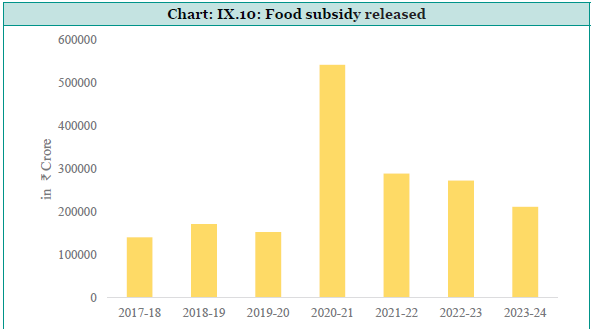
Conclusion: The agriculture sector, crucial for India’s economic growth, has grown at 4.18% annually over the past five years. Emphasizing allied sectors like animal husbandry, dairying, and fisheries can boost farmers’ incomes more effectively than traditional crops. Transitioning to high-value agriculture (fruits, vegetables, fisheries, poultry, dairy) is essential. Crop diversification towards oilseeds, pulses, and horticulture requires investments in infrastructure, credit, and market institutions. Promoting private investment, technology, and reducing post-harvest losses are vital. Improving market infrastructure through E-NAM, FPOs, and cooperative participation can enhance price discovery. Incentivizing states to modernize agriculture marketing can drive better outcomes.




